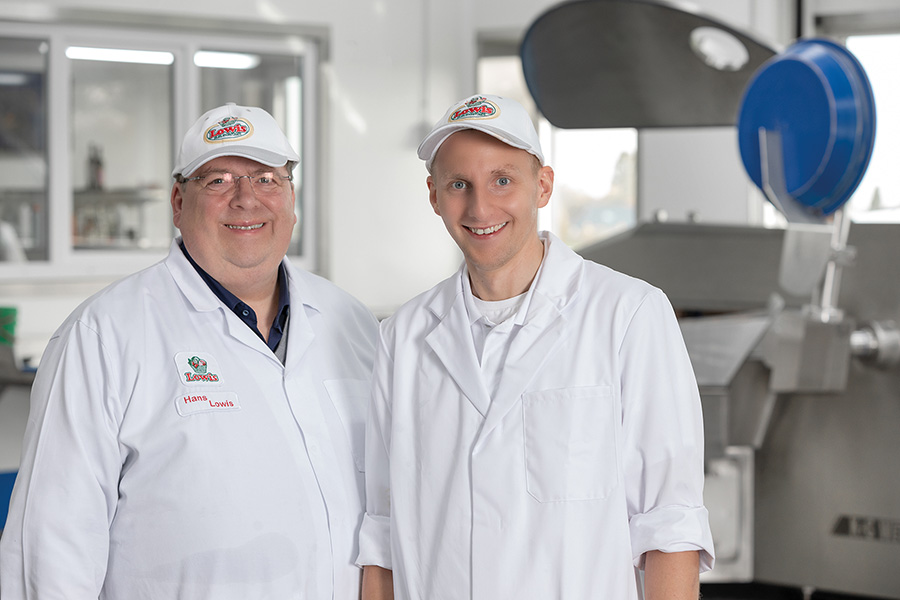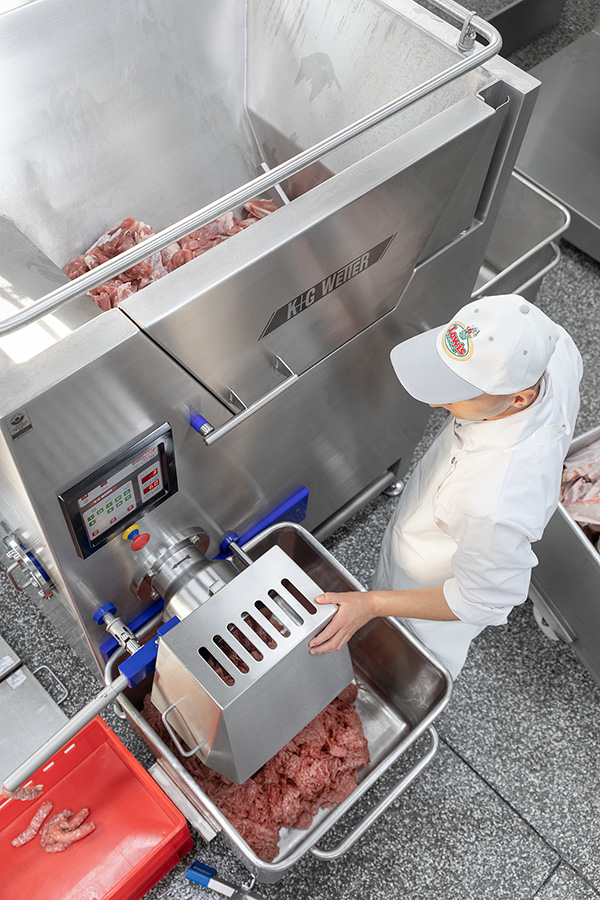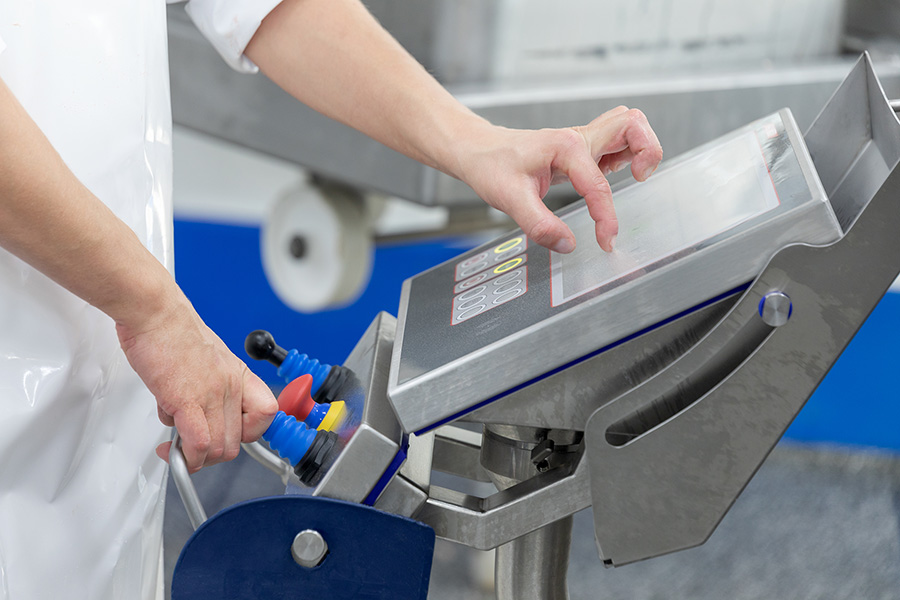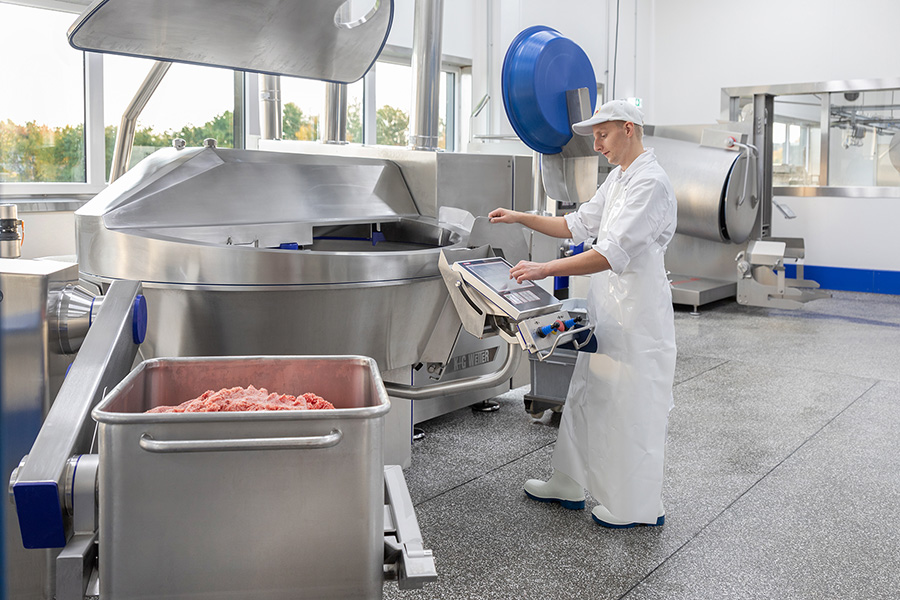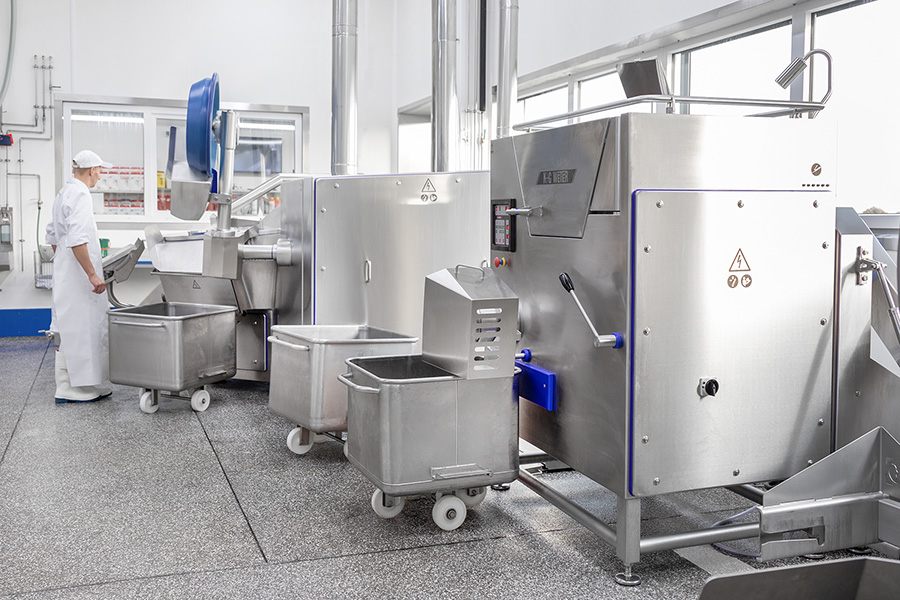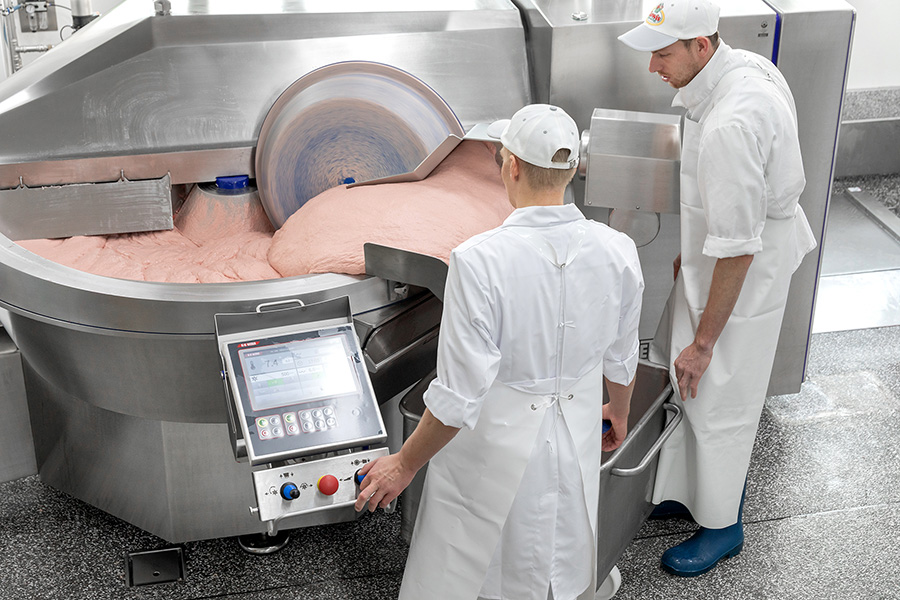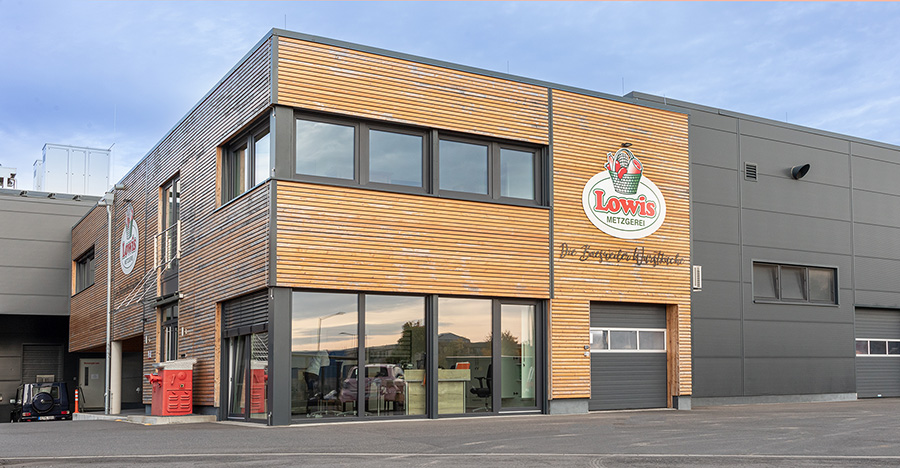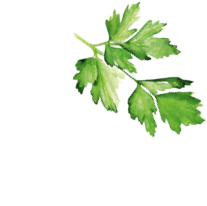

Industrial machines for artisanal family butchers
Is artisanal craftsmanship in the butcher’s shop reconcilable with the use of industrial machines? The Lowis butcher’s shop in the town of Setterich-Baesweiler thinks so! In the rural area of the Aachen city district, master butcher Hans Lowis and his son Niklas, together with eleven employees, produce liver sausage, ham sausage (Schinkenwurst) and many other traditional specialities just as they did in the first Lowis shop founded in 1955 – but now supported by machines that are also used by industrial companies.
VCM 360 and MWW 160
Vacuum cutters and angle grinders are delivered by K+G Wetter in Biedenkopf. These two companies share a long history. Hans Lowis took over the business from his parents in 1988 and was one of the first customers of meat processing machine manufacturer K+G Wetter, which itself was established in 1990. “We started with a small 65-litre bowl cutter and a 130-millimetre angle grinder,” says Hans Lowis, who has since handed butchery down to his son Niklas. “That bowl cutter was in service for 17 years. We then expanded to 120, 200 and now 360 litres.” Since May 2022, the VCM 360 Hygienic Secure and the MWW 160 mixer angle grinder have been performing reliably in the butchery. The Lowis family has constructed a new building on an industrial estate – with high-tech hiding behind a modern wooden façade.
The new machines have been standing in the new factory building since spring. Now, early in this late autumn morning, several batches of the popular Christmas liver sausage have already been chopped – a truly gourmet variety that contains cream and other fine ingredients according to the family recipe. “Liver sausage is our absolute best seller,” explains Niklas Lowis, who sells products made by the family business via two regional branches. Together with a wholesale partner, he also sells nationwide through food retailers and to the Benelux region.
Optimised cooking system for better quality and lower energy consumption
When it comes to the sausage meat used for the liver sausage, the optimised cooking system of the K+G Wetter cutters comes to the fore: The cutter bowl is a completely enclosed, double-walled system. Hans Lowis is fully convinced of the advantages this offers for his speciality butchery product: “There is less deposition of the sausage meat and lower caramelisation in the bowl. This has made our liver sausage even better. In the past, product deposits forming on the cooking bowl made intermediate cleaning of the bowl common after every ten batches approximately. Today, practically nothing remains in the bowl cutter after unloading. This is clearly due to the double-walled bowl. Previously, the bowl was heated far less evenly via steam nozzles. Now the steam is evenly distributed in the intermediate space.” “On top of this comes the machine’s design: We have achieved an extremely low vibration level thanks to the cast iron machine base and can bring the bowl and blade very close together,” adds Heiko Schneider, Area Sales Manager at K+G Wetter. “Talking to customers has taught me that product becoming baked on is a bigger problem when the bowl/blade spacing is greater. These are issues that you might not associate with product quality at first glance, but they have a massive impact.” Product quality that delights customers also benefits from sophisticated technology.
A further advantage: Whereas the entire vacuum vessel area used to heat up during the cooking process, now only the small space between the cutter bowl walls is heated, thereby saving time and energy. The issue of energy is huge. Niklas Lowis has prepared some figures: “The machine has one-and-a-half times the capacity of the VCM 200, but its peak current load has actually been reduced. If you add to this the fact that we could already produce 400 kilogrammes of Mettwurst sausage meat in the 360-litre bowl without anything overflowing, the machine’s economical consumption of precious energy resources becomes even clearer.” “This is only possible thanks to the raised bowl rim and special bowl geometry,” explains Heiko Schneider. But Niklas Lowis also occasionally uses the VCM 360 for smaller special production batches. “I also make 40 kilogrammes of stuffing mix in the cutter. So it’s also possible to make small quantities with it, the product is well processed and it makes financial sense.” It was therefore unnecessary for the Lowis butcher’s shop to purchase a separate small bowl cutter for such tasks.
Grinder and bowl cutter hygiene and quality
Meanwhile, in the bright and airy production area, Lowis employee Moris Porkert cleans the cutter for processing the next batch. A further regional speciality, Rheinische Schinkenwurst (Rhineland ham sausage), is also on the production schedule. Fleischwurst or Lyoner is the name of the fine boiled sausage found in other regions of Germany. Thanks to the innovations offered by K+G Wetter’s Hygienic Secure range, Lowis’ employees spend significantly less time on the absolute hygienic cleaning of the bowl cutter. “I am absolutely convinced of the benefits of Hygienic Secure,” says Niklas Lowis. “It wasn’t even on my radar when I was shopping for a machine, but it’s phenomenally easy to clean and really good – for example, because you can remove the knife cover strips. In our experience, Hygienic Secure consistently saves us 20 per cent in terms of cleaning time!”
The meat for the Schinkenwurst initially passes through the MWW 160 mixer angle grinder, which took its place in Lowis’ premises at the same time as the industrial bowl cutter. “The MWW 130 we had before had started to show its age and couldn’t cope with the increased demands we were placing on it,” says Hans Lowis. The master butcher also places particular importance on the Easy Access feature. “The design with a door in the grinder’s hopper was indispensable for us when we bought the new machine. We would have really regretted not having it, because it’s so ingenious to use – it’s right at the top in a class of its own. No other grinder offers such ease of access.” Despite its industrial size, practical experience shows that all Lowis employees are able to operate the machine perfectly and remove and refit the mixing paddle and meat worm very easily, quickly and effortlessly during cleaning.
Of course, the Lowis butchery produces minced meat using the grinder – “The cutting pattern has become even clearer”, Niklas Lowis is pleased to say – and minces meat before cutting: “We don’t put anything in the cutter that hasn’t first been ground”. This is due to the sorting device, which reliably removes unwanted components in the meat, such as sinews and bone splinters. “We already have the sorting device in our third machine from K+G Wetter. It was always fantastic, but has been greatly improved thanks to various technical innovations and especially by the new sorting knife.” Lowis also finds the lateral unloading of the sorted material a convincing feature. “There’s nothing to obstruct the cutting set housing which allows it to be cleaned easily and quickly.”
Thanks to the stick mixing shaft, the butchery also processes frozen material using the MWW 160: “Our cold store operates at -4 degrees (Celsius). This delivers slightly frozen blocks which we chop and mince perfectly using the mincer and special mixing shaft,” reports Niklas Lowis.
Moreover, the MWW 160 from K+G Wetter also offers sophisticated solutions in terms of hygiene – for example, the rinsing chamber, which allows the area behind the meat worm, feeder worm and mixing paddle seals to be simply rinsed from the outside on a daily basis: Even if tiny particles penetrate these seals as a result of the grinding pressure, they cannot form deposits which provide a breeding ground for germs. “The rinsing chamber is so good that it’s completely unobtrusive in daily operations,” smiles Hans Lowis. “We just rinse it through and that’s it.” Disassembling the worms and mixing shafts for cleaning is also extremely easy thanks to the easy-access door in the grinder’s hopper and the quick-release fasteners. “You have access to all parts of the machine and it’s always sparkling clean,” says senior boss Lowis.
A fine sense for perfect artisanal sausages
Niklas Lowis opens the noise protection lid of the neighbouring VCM 360. The excellently-guided hydraulic loading system precisely doses the previously minced meat into the cutter bowl. Gradually, more ingredients are added – spices, salt, ice, more meat. Niklas Lowis starts each work step by hand. “Two-four?” he calls out to his father in between – it’s about the right speed for the next production step. Lowis senior signals his agreement – he has all the recipes along with quantities, ingredients and work processes in his head. So sausage production at Lowis is still real artisanal craftsmanship, even using the large industrial bowl cutter.
After just a few minutes, the sausage meat is ready and Niklas Lowis ejects it with the unloader into the waiting meat trolleys. A few months ago the cutter would still have been in the middle of production, but now it is already ready for the next batch. “Our experience shows that the time saving is around 40 per cent. It was previously ten minutes, now it’s six – that’s already an insane gain from an economic point of view.” Another advantage: “Like many other companies, we are also suffering from a shortage of staff. That’s why we search out every opportunity for saving working time while maintaining or improving quality,” says Niklas Lowis. The small company therefore relies on large bowl cutters and grinders from K+G Wetter.
The company does not save time by using higher speeds: According to Hans Lowis, “This only increases power consumption and causes bearing wear; there is simply no benefit.” On the other hand, the master butcher relies on careful preparation, for example prior grinding, and on artisanal tricks such as knowing the right time to add salt. Niklas Lowis describes the finished Schinkenwurst as follows: “The sausage has an artisanal structure. We could of course cut the sausage meat absolutely finely and smoothly, but it would then have a completely different texture. Our method using the industrial cutter – by chopping more slowly and for longer rather than quickly and at top speed – gives the sausage a texture like the one from the butcher’s shop next door. It’s something that becomes clearly apparent when you eat it.”
Customised touch panel
A special feature programmed by the K+G Wetter team to address the specific needs of the Lowis butcher’s shop is the control panel that has been customised to provide the functions needed by the business every day. For example, all nine knife speed buttons have been assigned twice, which means that Niklas Lowis only has to double tap to set the perfect speed. The touch fields for vacuum, temperature and bowl revolutions have received similar treatment.
Service experts and customer relations on an equal footing
In order to ensure the machine is maintained in perfect condition at all times, customer service is an important background issue. Senior boss Hans Lowis enthuses about his many years of experience: “K+G Wetter is as family-oriented as we are. With them we have a direct line to the management and don’t get tied up in a call centre when there’s a problem to be solved. Like us, they are fully grounded. Their customer service staff are simply unbeatable too. They always endeavour to find a direct solution. It’s something money can’t really buy.”
“With them, the boss – in fact both bosses – are still directly involved in production and are fantastic role models for their employees. I am able to talk to them directly, not to a department head. That’s what I call a customer relationship on an equal footing,” adds Heiko Schneider.
Ideas derived from practice for the perfect machine
After finishing the current batch of boiled sausage meat, Hans Lowis and K+G Wetter area sales manager Heiko Schneider meet at the machine to discuss ideas, just as they have during the entire duration of their long-standing collaboration. “We are always really pleased to accept suggestions derived from practical experience and pass them on to our design department,” says Heiko Schneider. It’s all about the details: “From my perspective, the VCM 360 is currently the absolutely perfect machine,” says Hans Lowis with complete conviction.
Press photos: © K+G Wetter
Photo 1: Second- and third-generation master butchers Hans Lowis (left) and his son Niklas run the traditional business from the district of Aachen.
Photo 2: Undesired components such as bone splinters or pieces of sinew are automatically and reliably removed during the grinding process and ejected to the side. Simultaneously, the working area in front of the machine remains free – giving the sorting device of K+G Wetter grinders decisive advantages.
Photo 3: The touch panel of the VCM 360 from K+G Wetter can be custom programmed in accordance with customer requirements – thereby facilitating optimal workflows.
Photo 4: The VCM 360 “Hygienic Secure” is convenient to operate and saves time and energy during processing and cleaning. “It’s the perfect machine,” comments master butcher Niklas Lowis.
Photo 5: The Lowis butcher’s shop relies on the MWW 160 (front) and the VCM 360 from K+G Wetter. These efficient production machines save the company time and money – and deliver enhanced quality.
Photo 6: The design of the VCM 360 allows the bowl volume to be utilised optimally – to produce large, top-quality batches without losses caused by overflowing.
Photo 7: Liver sausage is one of the Lowis’ specialities – Niklas Lowis and his father Hans offer the entire range of butchery products.
Photo 8: The Lowis butcher’s shop was founded in 1955. In the new building, artisanal specialities are produced behind the modern wooden façade using high-tech machines.
